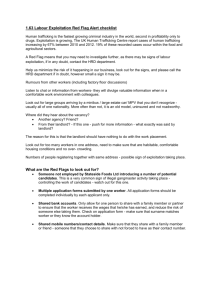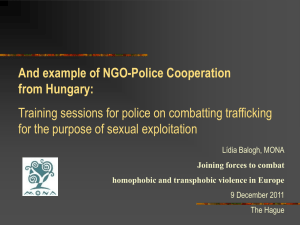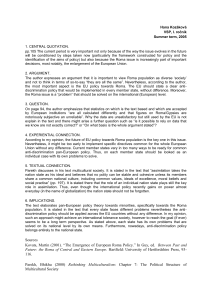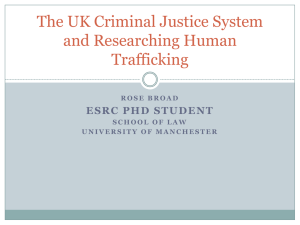Presentations as handout
advertisement
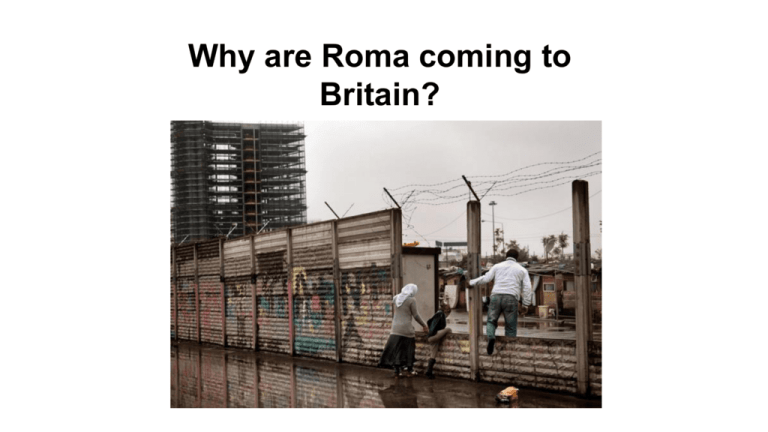
Why are Roma coming to Britain? Jake Bowers • Romani journalist – BBC radio and TV – Guardian/Independent – Travellers Times • Diversity Trainer • Researcher – Local and central government Journalism What’s in a name? • Gypsy – corruption of Egyptian • Traveller – nomadic of any origin • Romany – noun and adjective • Roma – “husbands” • Tsigan/Zigeuner – from greek Athinganoi – “heretic” Push / Pull • Romany migration has always been driven by the push of persecution and the pull of economic opportunity Housing Education • Massive over representation in special schools • Very few finish secondary education • Even less higher or further education Employment • Massive unempoyment • Discrimination in labour market • Lack of official papers Health • Environmental marginalised • Lowest life expectancy • Highest child mortality • Bad access to healthcare Inequality • • • • • • • Romania Italy Greece Slovakia Czech Republic Hungary France Maria and Natalka Thanks for listening Jake Bowers Tel: +44 7966 786242 jake.bowers@btinternet.com Bobby’s Home in Romania Bobby’s life in Luton Policing the Roma community: Tensions & Issues East of England Roma Professionals Network Conference 30th April 2014 PC Petr Torak DEMOGRAPHIC PROFILE OF ROMA COMMUNITY IN PETERBOROUGH Estimated number of Roma community is 3000 Mainly Czech & Slovak / Rumungro & Vlachi Roma Family based units Roma community by postcode 100% 80% 60% 40% 20% 0% PE1 PE2 PE3 PE4 PE7 TENSIONS & ISSUES Social and political situation Human trafficking Negative media Cannabis & Pervitin Child Safeguarding Anti-social behaviour Child Sexual Exploitation Child Sexual Exploitation CHILD SEXUAL EXPLOITATION Enhanced training for all PCs & PCSOs Training for taxi drivers MULTI-AGENCY APPROACH Peterborough Children Services Cambridgeshire Police Cambs & P’boro Foundation Trust P’boro and Stamford Hospital Trust Cambridgeshire Community Services Schools via Education Services Youth Offending Service Training for SIA licence holders Training for hotel staff www.peterboroughlscb.org.uk GYPSY ROMA TRAVELLER POLICE ASSOCIATION GYPSY ROMA TRAVELLER POLICE ASSOCIATION Promoting police work to candidates from the GRT background Challenging over & under policing Training of Police Officers and Staff Training for the GRT communities Engaging with media Raising profile of the GRT communities International collaboration ANY QUESTION … PC Petr Torak Cambridgeshire Police +44 7841948587 petr.torak@cambs.pnn.police.uk Trafficking and the Roma Community – Myths and Facts RACE in Europe Project: European Initiatives to Improve Response Against Trafficking for Forced Criminal Exploitation Fiona Waters – RACE in Europe Project Assistant, Anti-Slavery International Vicky Brotherton – Researcher and Coordinator of the Anti-Trafficking Monitoring Group ‘RACE in Europe’ Project • 2 year project with the aim of ‘improving knowledge and response to forced criminal activity and begging in Europe’ • Baseline assessment of scale and scope of trafficking for forced criminal exploitation and begging in Europe • 3 training sessions with a variety of stakeholders from across Europe • 7 Project partners from across Europe What is Human Trafficking? • Grave Human Rights abuse • United Nations Office on Drugs and Crime (UNODC) estimate 2.5 million victims at any given time • Affects every single country in the world • Types of exploitation include - sexual exploitation - forced labour - domestic servitude - forced criminal exploitation The 3 elements of trafficking: 1) Act (What is done) 2) Means (How it is done) 3) Purpose (Why it is done) Child Trafficking – No Means necessary Forced Criminal Exploitation and Forced Begging Directive 2011/36/EU on Preventing and Combating Trafficking in Human Beings and Protecting its Victims: Article 2 (3) Exploitation shall include, as a minimum, the exploitation of the prostitution of others or other forms of sexual exploitation, forced labour or services, including begging, slavery or practices similar to slavery, servitude, or the exploitation of criminal activities, or the removal of organs. • RACE Research findings include trafficking for: - cannabis cultivation - ATM theft, benefit fraud and other crime - forced begging • Victims treated as criminals • Non-punishment and non-prosecution obligations What are the causes of trafficking? - Complex phenomenon Socio, economic factors Varies for individual and region Poverty, oppression, lack of social or economic opportunity - Need to migrate - Opportunities for criminals to exploit the vulnerable - Key cause = VULNERABILITY • Why the Trafficking of Roma? • Suffer discrimination, poverty and unemployment • Lack of access to services • Debt and ‘Kamatari’ • Complex grooming patterns of exploiters • Good of the child versus good of the family Case Study - Operation Golf • Joint Investigation Team: Metropolitan Police (UK) and Romanian National Police • Network of criminals trafficking and exploiting Roma children • Over 1,000 taken from one town in Romania (Tanderai) • Discovered a child can earn as much as £100,000 a year. • Trafficked for street crime: • • • • • Pick-pocketing Bag-snatching Shoplifting ATM and distraction theft Forced begging The UK • 2,255 potential trafficking victims identified in 2012: 16% forced to commit crime • Victims exploited in more than one way • Incidences reported by the media and service providers • Emerging trends: sham marriage, drug trafficking, illegal charity bag collection, counterfeit goods. Petty Crime & Begging • Children from Central & Eastern Europe (commonly Roma) • 1,944 children arrested for theft offences since 2011 • • • • • 53% Romania 18% Poland 9% Lithuania 5% Czech Republic 5% Slovakia • Only 52 in the care of local authorities during the same period Rest of Europe • Existing reports & first-hand data contain cases of victims forced to commit a range of criminal activities • Partners in the Netherlands focusing on Trafficking of Roma • Data collection systems inadequate for complete picture • Certain groups particularly vulnerable to exploitation: • Bulgarian case-study – Roma represent 50-80% of all Bulgarian trafficked persons • Counter-trafficking initiatives can result in displacement effectInternational cooperation vital. What to do if you suspect a situation of trafficking Trafficking Indicators: • Lack of/false documents • Fear • Movements controlled • Unaware of location/cannot speak language • Signs of abuse • No access to Earnings • Debt For more information go to: 1) London Safeguarding Board Trafficking Toolkit 2) NSPCC website 3) UNODC Human Trafficking Indicators (https://www.unodc.org/pdf/HT_indicators_E_LOWRE S.pdf) If you suspect a victim of trafficking: 1)Go to the police with details (anti-trafficking unit) 2)Contact an NGO – Salvation Army 24hr helpline – 03003038151 3)Anti-Slavery International - 02075018927 Recommendations • Guidance for front-line professionals who may encounter trafficking victims • Training to increase awareness • Removal of culture of disbelief • Acknowledge and address vulnerabilities of Roma communities. • Greater international cooperation to tackle traffickers • Implementation of non-punishment legislation • EU Directive/CoE Trafficking Convention RACE In Europe Project www.raceineurope.org f.waters@antislavery.org United Kingdom Human Trafficking Centre Ayesha Ahad Address: PO BOX 5837, NW1W 9JZ Tel: (+44) 08447782406 (24/7) Email: UKHTC@nca.x.gsi.gov.uk Web: www.nationalcrimeagency.gov.uk OFFICIAL National Referral Mechanism (NRM) • The NRM was instigated on 1st April 2009 to implement part of the Council of Europe Convention on Action Against Trafficking in Human Beings. • Encourages co-operation between agencies involved in human trafficking cases to: Identify and recognise victims of human trafficking Provide a minimum 45 day reflection and recovery period Provide victims with care and support. OFFICIAL The Competent Authority The UK has two linked but separate Competent Authorities: • UK Human Trafficking Centre • Home Office (formerly UK Border Agency) OFFICIAL The Victim Identification Process OFFICIAL First Responders • Police • Home Office (formerly UKBA) • Gangmasters Licensing Authority (GLA) • Salvation Army – 0300 3038151 • NCA • Local Authorities • Health and Social Care Trusts (Northern Ireland) • Trafficking Awareness Raising Alliance (TARA) – 0141 2767724 • NSPCC (Child Trafficking Advice Centre) – 0800 1077057 • Migrant Helpline – 01304 218718/ 0141 8847900/ 01304 203977 • Poppy Project – 0207 7352062 • Medaille Trust – 0844 8009721 • Kalayaan – 0207 2432942 • Barnardo’s • Unseen UK – 0845 5441406 • BAWSO – 02920 644633 • New Pathways – 01685 379310 • Refugee Council OFFICIAL Overview of the Referral Process • The First Responder comes into contact with a PVoT • The First Responder completes the referral form accessed from www.gov.uk/government/publications/humantrafficking-victims-referral-and-assessmentforms • Completed referral forms are sent to the UKHTC: By fax on 0870 496 5534 By e-mail on UKHTC@nca.x.gsi.gov.uk OFFICIAL Completing the NRM Referral Form - Indicators Adults • • • • General indicators Indicators of forced labour Indicators of domestic servitude Indicators of sexual exploitation Children • Child development • Parenting capacity • Family/ environment OFFICIAL Completing the NRM Referral Form – Other Sections • Personal Details of the person being referred. • Contact details of the First Responder and also the social worker in the case of children. • Basic details of the encounter. • Evidence to support reasons for referral. • Adult referrals require signed informed consent to enter the NRM process. • Consent is not required for under 18’s. OFFICIAL The Decision Making Process OFFICIAL PALERMO PROTOCOL “The recruitment, transportation, transfer, harbouring or receipt of persons… …by means of the threat or use of force or other forms of coercion, of abduction, of fraud, of deception, of the abuse of power or of a position of vulnerability or of the giving or receiving of payments or benefits to achieve the consent of a person having control over another person… …for the purpose of exploitation. Exploitation shall include, at a minimum, the exploitation of the prostitution of others or other forms of sexual exploitation, forced labour or services, slavery or practices similar to slavery, servitude or the removal of organs” For children it is accepted that few children will have control over why they are moved, therefore the coercion or deception elements do not have to be present. Action Means Exploitation OFFICIAL Reasonable Grounds Decision • Identifies whether an individual is a potential victim of trafficking. • Target date of 5 working days from receipt. • The standard of proof is “I suspect but cannot prove…” • The decision is based on the referral form and other available information. • If a positive reasonable grounds decision is reached, the victim is entitled to a 45 day reflection and recovery period. OFFICIAL Conclusive Decision • Recognises whether an individual is a victim of trafficking. • Target date of 45 calendar days from the Positive Reasonable Grounds Decision. Case manager gathers additional information for relevant agencies • The standard of proof is “it is more likely than not” balance of probabilities. OFFICIAL Importance of the NRM Decision • Validation of a victim’s experience • Focused and targeted support to a victim and assistance with considering next steps • Independent corroboration of victim status OFFICIAL What happens next to a Victim? • Leave To Remain Discretionary Leave personal circumstances co-operating with police enquiries Other Leave to Remain application • Return home • Reconsideration • Judicial Review – review of process not decision OFFICIAL Upward Trend • For the whole of 2013: - 1746 total referrals into the UK NRM - 1032 relate to Home Office Cases - 714 cases dealt with by the UKHTC • Already in 2014 (up to 17/04/2014): - 690 total referrals into the UK NRM - 363 relate to Home Office Cases - 327 cases dealt with by the UKHTC OFFICIAL Any questions? UKHTC@nca.x.gsi.gov.uk 0844 778 2406 OFFICIAL Big Lottery Fund Roma Conference 30th April 2014 How the Lottery pound is spent ─ Camelot (5p) ─ Prize money (50p) ─ Taxes (12p) ─ Retailer (5p) ─ Good causes (28p) ─ Big Lottery Fund (11.2p) ─ Arts (5.6p) ─ Heritage (5.6p) ─ Sports (5.6p) Understanding the Funder Big Lottery Fund: Mission Statement ‘Bringing about real change to communities and to the lives of those most in need’ Big is an Outcomes Funder Community learning and creating opportunity Promoting community safety and cohesion Promoting well being Outcome 1 Outcome 2 Outcome 3 Outcome 4 People having better chances in life, with better access to training and development to improve their life skills Stronger communities, with more active citizens, working together to tackle their problems Improved rural and urban environments, which communities are better able to access and enjoy Healthier and more active people and communities Awards for All Awards for All – Who can apply? You can apply if you are a: ─ voluntary and community organisation, charity or social enterprise ─ school ─ parish or town council ─ Health body You can apply at any time during the year You can apply if.. UK Bank Account in name of organisation with two signatories At least three months notice Three unrelated people on governing body Complete within one year Please see Good Governance Guide How much? • £300 to £10,000 • One application at a time • End of Grant report approved before you can apply again • No more than £10,000 in any one year period • No match funding requirements Change - £10,000 in one year period What can Awards for All pay for? • equipment hire or purchase • IT equipment • building and refurbishment • sessional workers • updating equipment and premises for health and safety • training • volunteer expenses • transport costs • venue hire Examples of what Awards for All cannot pay for: ─ Activities starting before BIG confirms the grant ─ Day-to-day running costs ─ Existing activities and repeat or regular events. [Exceptions: 3 yrs since activity has taken place; delivery to new beneficiary types; Org has annual turnover <£30k] ─ Items that mainly benefit an individual ─ Building and refurbishment work costing more than £25,000 (inc. VAT) Repeat activities (see guidance page 9) Awards for All cannot pay for: (continued) ─ Salaries of permanent or fixed term staff ─ Projects or activities that the state has a legal obligation to provide ─ Political or religious activities ─ Routine repairs and maintenance ─ Fundraising activities ─ Used vehicles Application process You read our guide You send us your application We let you know our decision You send the documents we ask for We confirm the grant You start your project 30 20 10 • working days • working days • working days Awards for All - Improving your chances BIG scores applications to help decide who should be funded. Applications will score higher if they: ─ show strong evidence of need ─ seek to involve as wide a range of people as possible ─ meet more than one of our outcomes ─ are from groups that have never received an Awards for All grant ─ are from groups with a smaller annual income ─ are for smaller projects The scoring guide used to assess Awards for All is on the website Reaching Communities Who Can Apply? You can apply if you are a: ─ voluntary and community organisation, charity or social enterprise ─ school ─ parish or town council ─ Health body You can apply at any time during the year The Money!! Maximum grant: – No revenue limit. If asking for more than £500,000 tel: 08454102030 first – Up to £100,000 BIG contribution towards capital costs. No maximum capital project limit. (BIG would need to be the primary contributor). – Projects seeking more than £300,000 must be examples of excellent practice – Those seeking £100k+ a year should consider a range of funding options Minimum grant: £10,000 A project can be funded for a minimum of 1 year and a maximum of 5 years What can be funded? Revenue: • Salaries of project workers • Recruitment, training costs and staff expenses (travel, phones, stationery etc.) • Rent, heating, lighting, maintenance and insurance • Monitoring and evaluation of project • Full Cost Recovery – BIG can make a reasonable contribution towards existing overhead costs to deliver a BIG project. What can be funded? Capital: • Building and engineering works required to deliver project • Plant and equipment necessary for running the project • Purchase of land, buildings, equipment or fixtures • Transport necessary for delivering the project The Application Process You can apply at any time Stage 1 – Submit a Stage 1 form Response within 4 weeks Responses: ‘Maybe’ or ‘unlikely’ or ‘outside funding policy’ If ‘maybe’, you will be invited to submit a full application Stage 2 – Submit a full application within 4 months If seeking less than £40k a year, decision within 2 months If seeking more than £40k a year or about land or buildings, decision within 4 months Final decision made by an England-wide committee www.biglotteryfund.org.uk Roma Professionals Network 30th April 2014 Michelle Armstrong EU Connects Associate Introduction EU Institutions and Member States – joint responsibility to improve social inclusion and integration of Roma MS have primary responsibility/competences to change the situation of marginalised populations, but to support them, the EU has made available a range of legal, policy and financial instruments. EU policy context - key strategies/policies Key Funding Programmes to monitor as we move towards the 2014-20 EU funding programming period Key EU Policy Documents Directive on Racial Equality, Year 2000 April 2010 Communication on the economic and social integration of the Roma in Europe April 2011 Commission Communication on an EU Framework for National Roma Integration Strategies by 2020 "National Roma Integration Strategies: a first step in the implementation of the EU Framework“ Communication 21 May 2012. December 2013 - First ever EU legal instrument for Roma inclusion adopted – MS commitment to action 4th April 2014 - Commission Report on progress achieved through National Roma Strategies (focus on education, employment, healthcare & housing) Funding: Allocating sufficient funding to Roma integration remains a challenge. For the first time in 2014-20 period, 20% of the European Social Fund available to Member States must be dedicated to social inclusion, (up from current average of 15%). Post 2020, the Commission will explore ways to further improve/make more effective financial support for Roma including through a specific facility. Loss of potential - renders the endeavour to secure growth even more difficult…. Better integration of Roma is both a moral and an economic imperative. Three of five Europe 2020 headline targets directly linked to the EU Framework targets for Roma inclusion: fight against poverty and social exclusion raising employment levels reducing school drop-out and increasing attendance in tertiary education Multiple issues to tackle… Racism, discrimination, social exclusion Deep poverty and lack of access to healthcare and decent housing Victims of violence, trafficking and exploitation Lagging education levels and discrimination in the labour market High unemployment Low skills and low paid jobs EU Instruments to deliver policy! Funding in the form of grants to projects or organisations to help implement EU policies = powerful tool to improve the socio-economic situation of disadvantaged groups Funds are available to improve the economic situation, health, living conditions, employment opportunities, cultural understanding and education of all in Europe Structural and Investment Funds – The European Growth Programme in England – delivered through LEP! European Social Fund (ESF) which supports the improvement of living and working conditions of Roma in particular by investing in education and skills development European Regional Development Fund (ERDF), which supports regional development, economic change, enhanced competitiveness and territorial cooperation throughout the EU (ERDF is also available through Territorial Cooperation programmes - cross border, transnational and interregional funding) The 2014-2020 Structural Funds Regulations have the potential to re-direct Member States’ efforts to meet the needs of Roma Under the EU European Social Fund (ESF) Regulation, Roma are specifically included as beneficiaries of the 20% earmarked funds that the ESF should devote to social inclusion and the fight against poverty. Rights, Equality and Citizenship Programme 2014-20 Budget of 439m euros for 7 years, 54.8m in 2014 Prevent and combat violence against children, young people and women and to protect victims and groups at risk (from Daphne III of 2007-13) Non-discrimination on the grounds of ethnic origin. The programme brings in anti-discrimination and diversity sections of PROGRESS 200713 (Programme for Employment and Social Solidarity). Programme for Employment and Social Innovation (EaSI) 2014-20 Support development of EU policy in the areas of employment, social integration and working conditions EaSI combines elements of PROGRESS, The European Employment Service & European Progress Microfinance facility 815m euros over 7 years of which 500m for PROGRESS activities Social innovation/testing policy reform/ new ideas, products, services, models with strong methodology Other EU funds to monitor for the 2014-20 period… ERASMUS + for various lifelong learning projects – mobility, cooperation for innovation, policy reform Creative Europe –Culture and creative sectors/skills 2 Seas Cross Border and France-England Cross Border (ERDF) Programmes – e.g. social innovation Health for Growth – inequalities are identified as an objective – access to medical expertise, info for specific conditions beyond national borders, improve healthcare quality Europe for Citizens –Citizenship/democracy My contact details… Michelle Armstrong EU Connects Associate michelle.armstrong@eelga.gov.uk Tel: 07709 483445 Funding Opportunities for Roma & migrant communities What do we fund? • project funder (up to three years) • exploring histories of individuals and communities • collections of items, archives or other materials • creative activities that enable people to learn about heritage • historic anniversaries Who do we fund? • not for profit organisations Our grant programmes The slides that follow describe a selection of our current programmes For a full list, please visit http://www.hlf.org.uk Sharing Heritage £3,000 - £10,000 Grants to help share and explore community heritage Projects lasting up to 12 months NO fixed match-funding requirement One short application form Apply at any time Decision in around 10 weeks Any not-for-profit group can apply Our Heritage £10,000 to £100,000 Grants to help share and explore community heritage Projects lasting up to 3 years NO fixed match-funding requirement One application form Apply at any time Decision in around 10 weeks Any not-for-profit group can apply, local authorities & partnerships Young Roots £10,000 to £50,000 Grants to help young people (11 to 25) take part in heritage activities Projects lasting up to 3 years NO fixed match-funding requirement One application form Apply at any time Decision in around 10 weeks projects MUST be a partnership between a youth body and a heritage organisation Heritage Grants £100,000 upwards Projects lasting up to 3 years Two stage application Quarterly deadlines, decisions within 3 months Match funding is required What we look for: Project Outcomes This is the difference your project will make with HLF funding. We look for the changes you will make for: • Heritage • People • Communities Outcomes we require are different for each programme. BUT ALL projects must enable people to learn about heritage! Before you apply: • Call us! Outline your idea and get some initial feedback • Complete a short project enquiry form on our website: www.hlf.org.uk • We will respond within around 10 working days with advice to help you develop a full application • We can offer face-to-face advice sessions: see our website for details! www.hlf.org.uk Contact us Rachel Fuller, Development Officer 01223 224880 rachelf@hlf.org.uk @HLFEoE Heritage Lottery Fund Terrington House 13-15 Hills Road Cambridge CB2 1NL
